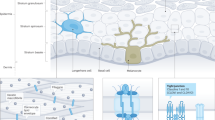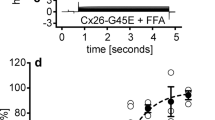Abstract
Lamellar ichthyosis (LI) is a disfiguring skin disease characterized by abnormal epidermal differentiation and defective cutaneous barrier function1,2. LI has been associated with loss of keratinocyte transglutaminase 1 (Tgase1)3,4, an enzyme believed necessary for normal formation of the cornified epidermal barrier. Using LI as a prototype for therapeutic cutaneous gene delivery, we have used the human skin/immunodeficient mouse xenograft model to correct the molecular, histologic and functional abnormalities of LI patient skin in vivo. We have used Tgase1–deficient primary keratinocytes from LI patients combined with high–efficiency transfer of functional Tgase1 to regenerate engineered human LI epidermis on immunodeficient mice. Engineered LI epidermis displayed normal Tgase1 expression in vivo, unlike unengineered LI epidermis where Tgase1 was absent. Epidermal architecture was also normalized by Tgase1 restoration, as was expression of the epidermal differentiation marker filaggrin. Engineered LI skin demonstrated restoration of cutaneous barrier function measures to levels seen in epidermis regenerated by keratinocytes from patients with normal skin, indicating functional correction in vivo of the proposed primary pathophysiologic defect in LI. These results confirm a major role for Tgase1 in epidermal differentiation and demonstrate a potential future approach to therapeutic gene delivery in human skin.
This is a preview of subscription content, access via your institution
Access options
Subscribe to this journal
Receive 12 print issues and online access
$209.00 per year
only $17.42 per issue
Buy this article
- Purchase on Springer Link
- Instant access to full article PDF
Prices may be subject to local taxes which are calculated during checkout
Similar content being viewed by others
References
Williams, M.L. & Elias, P.M. Genetically transmitted, generalized disorders of cornification. Dermatol. Clin. 5, 155–178 (1987).
Bale, S.J. & Doyle, S.Z. The genetics of ichthyosis: A primer for epidemiologists. J. Invest. Dermatol. 102, 49S–50S (1994).
Huber, M. et al. Mutations of keratinocyte transglutaminase in lamellar ichthyosis. Science 267, 525–528 (1995).
Russell, L.J. et al. Mutations in the gene for transglutaminase 1 in autosomal recessive lamellar ichthyosis. Nature Genet. 9, 279–283 (1995).
Khavari, P.A. et al. BRG1 contains a conserved domain of the SWI2/SNF2 gene family necessary for normal mitotic growth and transcription. Nature 366, 170–174 (1993).
Gibson, D.F., Ratnam, A.V. & Bikle, D.D. Evidence for separate control mechanisms at the message, protein, and enzyme activation levels for transglutaminase during calcium-induced differentiation of normal and transformed human keratinocytes. J. Invest. Dermatol. 106, 154–161 (1996).
Gallico, G.G. et al. Permanent coverage of large burn wounds with autologous cultured human epithelium. N. Engl. J. Med. 311, 448 (1984).
Briggaman, R.A. Localization of the defect in skin diseases analyzed in the human skin graft-nude mouse model. Curr. Probl. Dermatol. 10, 115 (1980).
Kim, Y. et al. Recessive dystrophic epidermolysis bullosa phenotype is preserved in xenografts using SCID mice: Development of an experimental in vivo model. J. Invest. Dermatol. 98, 191–195 (1992).
Medalie, D.A. et al. Evaluation of human skin reconstituted from composite grafts of cultured keratinocytes and human acellular dermis transplanted to athymic mice. J. Invest. Dermatol. 107, 121–127 (1996).
Fenjves, E.S., Yao, S.-N., Kurachi, K. & Taichman, L.B. Loss of expression of a retrovirus-transduced gene in human keratinocytes. J. Invest. Dermatol. 106, 576–578 (1996).
Gerrard, A.J., Hudson, D.L., Brownlee, G.G. & Watt, F.M. Towards gene therapy for haemophilia B using primary human keratinocytes. Nature Genet. 3, 180–183 (1993).
Dale, B.A., Gown, A.M., Fleckman, M.D., Kimball, J.R. & Resing, K.A. Characterization of two monoclonal antibodies to human epidermal keratohyalin: Reactivity with filaggrin and related proteins. J. Invest. Dermatol. 88, 307–313 (1987).
Lavrijsen, A.P. et al. Barrier function parameters in various keratinization disorders: Transepidermal water loss and vascular response to hexyl nicotinate. Br. J. Dermatol. 129, 547–553 (1993).
Mancini, A.J., Sookdeo-Drost, S., Madison, K.C., Smoller, B.R. & Lane, A.T. Semipermeable dressings improve epidermal barrier function in premature infants. Pediatr. Res. 36, 306–314 (1994).
Garlick, J.A., Katz, A.B., Fenjves, E.S. & Taichman, L.B. Retrovirus-mediated transduction of cultured epidermal keratinocytes. J. Invest. Dermatol. 97, 824–829 (1991).
Kinsella, T.M. & Nolan, G.P. Episomal vectors rapidly and stably produce high-titer recombinant retrovirus. Hum. Gene Ther. 7, 1405–1413 (1996).
Roop, D. Defects in the barrier. Science 267, 474–475 (1995).
Ottey, K.A., Wood, L.C., Grunfeld, C., Elias, P.M. & Feingold, K.R. Cutaneous permeability barrier disruption increases fatty acid synthetic enzyme activity in the epidermis of hairless mice. J. Invest. Dermatol. 104, 401 (1995).
Taichman, L.B. Epithelial gene therapy. in The Keratinocyte Handbook. (eds. Leigh, I., Lane, B. & Watt, F.) 543–551 (Cambridge Univ. Press, 1994).
Greenhalgh, D.A., Rothnagel, J.A. & Roop, D.R. An attractive target tissue for gene therapy. J. Invest. Dermatol. 103S, 63S–69S (1994).
Vogel, J.C. Keratinocyte gene therapy. Arch. Dermatol. 129, 1478–1483 (1993).
Fenjves, E.S. Approaches to gene transfer in keratinocytes. J. Invest. Dermatol. 103, 70S–75S (1994).
Khavari, P.A. & Krueger, G.G. Cutaneous gene therapy. Dermatol. Clin. (in the press).
Rheinwald, J.G. & Green, H. Serial cultivation of strains of human epidermal keratinocytes. Cell, 6, 331 (1975).
Thacher, S.M. & Rice, R.H. Keratinocyte-specific transglutaminase of cultured human epidermal cells: Relation to cross-linked envelope formation and terminal differentiation. Cell 40, 685–695 (1985).
Ta, B.M., Gallagher, G.T., Chakravarty, R. & Rice, R.H. Keratinocyte transglutaminase in human skin and oral mucosa: Cytoplasmic localization and uncoupling of differentiation markers. J. Cell Sci. 95, 631 (1990).
Murphy, G.F., Flynn, T.C., Rice, R.H. & Pinkus, G.S. Involucrin expression in normal and neoplastic human skin: A marker for keratinocyte differentiation. J. Invest. Dermatol. 82, 453–457 (1984).
Ivanyi, D. et al. New monoclonal antibodies recognizing epidermal differentiation-associated keratins in formalin-fixed, paraffin embedded tissue: Keratin 10 expression in carcinoma of the vulva. J. Pathol. 159, 7–12 (1989).
Roop, D.R. et al. Synthetic peptides corresponding to keratin subunits elicit highly specific antibodies. J. Biol. Chem. 259, 8037–8040 (1984).
Author information
Authors and Affiliations
Rights and permissions
About this article
Cite this article
Choate, K., Medalie, D., Morgan, J. et al. Corrective gene transfer in the human skin disorder lamellar ichthyosis. Nat Med 2, 1263–1267 (1996). https://doi.org/10.1038/nm1196-1263
Received:
Accepted:
Issue Date:
DOI: https://doi.org/10.1038/nm1196-1263
This article is cited by
-
New developments in the molecular treatment of ichthyosis: review of the literature
Orphanet Journal of Rare Diseases (2022)
-
In vivo topical gene therapy for recessive dystrophic epidermolysis bullosa: a phase 1 and 2 trial
Nature Medicine (2022)
-
Treatments for Non-Syndromic Inherited Ichthyosis, Including Emergent Pathogenesis-Related Therapy
American Journal of Clinical Dermatology (2022)
-
Mutant collagen COL11A1 enhances cancerous invasion
Oncogene (2021)
-
Identifying a Hyperkeratosis Signature in Autosomal Recessive Congenital Ichthyosis: Mdm2 Inhibition Prevents Hyperkeratosis in a Rat ARCI Model
Journal of Investigative Dermatology (2014)



